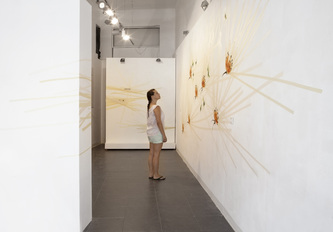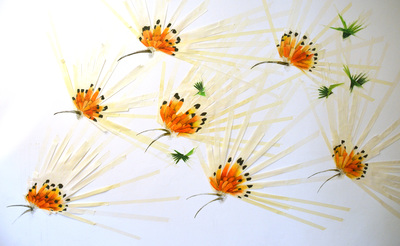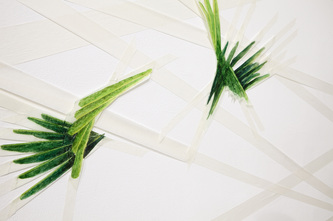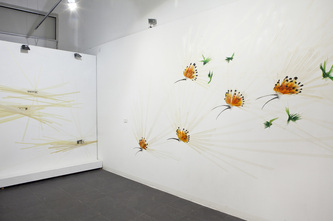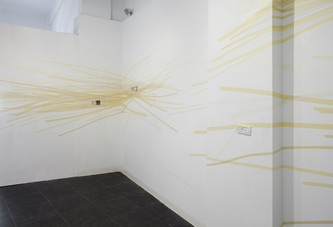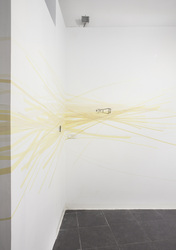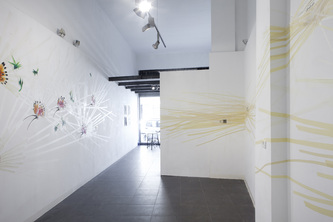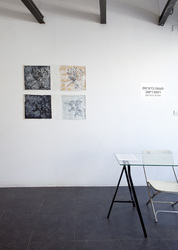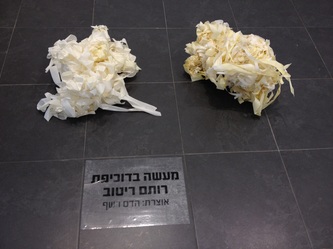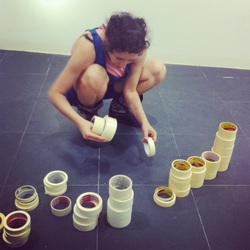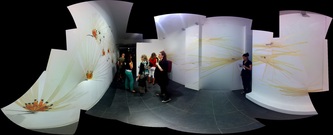Upupa Act Alfred Gallery, Tel Aviv, 2012
Curator: Hadas Reshef
Photoes: Liat Elbling
Upupa Act // Hadas Reshef
Hayyim Nahman Bialik tells of King Solomon: "away in the desert he built himself a playful city". There he flew on the back of a great, strong and long winged white eagle; this is the city of Tadmor. One day on his way to the city of Tadmor, "and the sun struck on his head, and he tired and fainted, almost fell to the ground." The Upupa king and his flock saw this, and came to help the king, "and they soared up and all hovered above Solomon's head, and they snugged their wings, woman to her sister, wing to wing, and become a shed and a cloud to protect the king's head, to rescue from his trouble". In return
for his rescue, king Solomon wished to generously reward the Upupas. The proud Upupa king asked, "may you please give all of us golden tufts, crowns for our heads?". King Solomon agreed, but warned that this request will result badly for them. The time past and indeed, the hunters found the gold on the Upupas' heads and began massacring them, almost to extinction. The Upupa king returned to King
Solomon, confessed his vanity, and asked to return the gift. King Solomon replied he would take off the gold from their heads, but since he cherished their favor he left feather tufts on their heads instead and "silenced the Upupas in their nests, and they bred across the land and wandered securely
without any distraction.
On Thursday, May 29th 2008, after a large scale democratic voting by hundreds of thousands of Israelis, president of Israel Shimon Peres announced the selection of The Upupa as the national bird of Israel. At the same time, and without entering any competition, a green bird nests in the Holy Land, it is the Psittacula krameri (Drara in Hebrew). The Drara is a species of parrot originated in India, which flew away in the 1980s from a breeding farm in Israel. Since then the Drara birds had settled and bred and became a permanent nesting bird along the coast area in Israel, while repressing local species.
In the 19th century, German historians defined the term "Völkerwanderung", which describes the tribal migration of the German and Slavic tribes between the 4th and the 9th centuries in Europe. The migration is a phenomenon that occured consistently throughout history, due to economic distress or various wars over geographic regions.
Since the time of Abraham and until today, the land of Israel had experienced different migrations, among them the migration of the Jewish people. The origin of the term "Ingathering of the exiles" lay in Moses' last words to the Israeli people before entering the promise land. There he prophesied the future sins of Israel and their exile from the land, as was also predicted later on by Isaiah and Ezekiel. The idea of "ingathering of the exiles" was adopted by the Zionist movement in the late 19th century, and is one of the fundamental concepts in the independence scroll of Israel. To establish a homeland for the Jews ingathering from the exiles in Israel, the state needs to defend itself. Israel's defense concept is based on the need to protect the state and its interests against possible threats, with priority for deterrence and prevention over offensive actions. One of these acts is the "Iron Dome"
rocket interception system for short range.
Rotem Ritov's exhibition, "Upupa Act", tie together points of reference relating to locality, migration, settlement and more, in a sensitive and complex manner: at the entrance to the exhibition, stands the huge painting "The Swimmers". At first glance, it looks like a huge griddler within an image of swimmers in the sea, but a second look reveals that the swimmers are soldiers lying in trenches, as was published in news coverage of the "Iron Dome" interception system training.
Next to the "Swimmers" (that signify, among other things, the sanctity of the "national defense" concept) stands the installation "The Wild East", which deals with the settlement enterprise project. It is a continuation of the exhibition "The Wild East" that was recently presented at the Haifa Museum as part of the "Alfred Express" project for the "Haifa-Jerusalem-Tel Aviv" exhibition. The fine charcoal outposts drawings on bursting masking tape strips, symbolize notions of temporariness, the will to attach and cling to the earth, even if the act is stilted (pasted). The "Wild East" installation was inspired
by landscape pictures of individual units of outposts, collected from various Internet articles about Judea and Samaria settlements activity. The outposts' phenomenon, such as the Psittacula krameri (Drara in Hebrew) invasion, is part of broader contemporary situations of migration, occupation,
exclusion, and harms the nesting of the local species.
Facing the "Wild East" installation, stands yet another masking tape installation, "The Upupa Act". These two installations deal with questions of Belonging and Territory – very contemporary common words in the everyday discourse on racism within the Jewish people and outside it, and in the discourse regarding the lack of coping with refugees from Africa.
The masking tape platform of the outposts, Upupa and the Drara drawings, contains inner-artistic values rooted at the Arte Povera genre back from the days of Moshe Gershuni and Michal Na'aman. The variety of yellow-brown toned masking tape stripes bursts metaphorically on the gallery's walls, clinging to them and occupying them.
The exhibition "The Upupa Act" wants to explore myths, legends and local heritage in relation to the over-complex reality of the State of Israel.
Hayyim Nahman Bialik tells of King Solomon: "away in the desert he built himself a playful city". There he flew on the back of a great, strong and long winged white eagle; this is the city of Tadmor. One day on his way to the city of Tadmor, "and the sun struck on his head, and he tired and fainted, almost fell to the ground." The Upupa king and his flock saw this, and came to help the king, "and they soared up and all hovered above Solomon's head, and they snugged their wings, woman to her sister, wing to wing, and become a shed and a cloud to protect the king's head, to rescue from his trouble". In return
for his rescue, king Solomon wished to generously reward the Upupas. The proud Upupa king asked, "may you please give all of us golden tufts, crowns for our heads?". King Solomon agreed, but warned that this request will result badly for them. The time past and indeed, the hunters found the gold on the Upupas' heads and began massacring them, almost to extinction. The Upupa king returned to King
Solomon, confessed his vanity, and asked to return the gift. King Solomon replied he would take off the gold from their heads, but since he cherished their favor he left feather tufts on their heads instead and "silenced the Upupas in their nests, and they bred across the land and wandered securely
without any distraction.
On Thursday, May 29th 2008, after a large scale democratic voting by hundreds of thousands of Israelis, president of Israel Shimon Peres announced the selection of The Upupa as the national bird of Israel. At the same time, and without entering any competition, a green bird nests in the Holy Land, it is the Psittacula krameri (Drara in Hebrew). The Drara is a species of parrot originated in India, which flew away in the 1980s from a breeding farm in Israel. Since then the Drara birds had settled and bred and became a permanent nesting bird along the coast area in Israel, while repressing local species.
In the 19th century, German historians defined the term "Völkerwanderung", which describes the tribal migration of the German and Slavic tribes between the 4th and the 9th centuries in Europe. The migration is a phenomenon that occured consistently throughout history, due to economic distress or various wars over geographic regions.
Since the time of Abraham and until today, the land of Israel had experienced different migrations, among them the migration of the Jewish people. The origin of the term "Ingathering of the exiles" lay in Moses' last words to the Israeli people before entering the promise land. There he prophesied the future sins of Israel and their exile from the land, as was also predicted later on by Isaiah and Ezekiel. The idea of "ingathering of the exiles" was adopted by the Zionist movement in the late 19th century, and is one of the fundamental concepts in the independence scroll of Israel. To establish a homeland for the Jews ingathering from the exiles in Israel, the state needs to defend itself. Israel's defense concept is based on the need to protect the state and its interests against possible threats, with priority for deterrence and prevention over offensive actions. One of these acts is the "Iron Dome"
rocket interception system for short range.
Rotem Ritov's exhibition, "Upupa Act", tie together points of reference relating to locality, migration, settlement and more, in a sensitive and complex manner: at the entrance to the exhibition, stands the huge painting "The Swimmers". At first glance, it looks like a huge griddler within an image of swimmers in the sea, but a second look reveals that the swimmers are soldiers lying in trenches, as was published in news coverage of the "Iron Dome" interception system training.
Next to the "Swimmers" (that signify, among other things, the sanctity of the "national defense" concept) stands the installation "The Wild East", which deals with the settlement enterprise project. It is a continuation of the exhibition "The Wild East" that was recently presented at the Haifa Museum as part of the "Alfred Express" project for the "Haifa-Jerusalem-Tel Aviv" exhibition. The fine charcoal outposts drawings on bursting masking tape strips, symbolize notions of temporariness, the will to attach and cling to the earth, even if the act is stilted (pasted). The "Wild East" installation was inspired
by landscape pictures of individual units of outposts, collected from various Internet articles about Judea and Samaria settlements activity. The outposts' phenomenon, such as the Psittacula krameri (Drara in Hebrew) invasion, is part of broader contemporary situations of migration, occupation,
exclusion, and harms the nesting of the local species.
Facing the "Wild East" installation, stands yet another masking tape installation, "The Upupa Act". These two installations deal with questions of Belonging and Territory – very contemporary common words in the everyday discourse on racism within the Jewish people and outside it, and in the discourse regarding the lack of coping with refugees from Africa.
The masking tape platform of the outposts, Upupa and the Drara drawings, contains inner-artistic values rooted at the Arte Povera genre back from the days of Moshe Gershuni and Michal Na'aman. The variety of yellow-brown toned masking tape stripes bursts metaphorically on the gallery's walls, clinging to them and occupying them.
The exhibition "The Upupa Act" wants to explore myths, legends and local heritage in relation to the over-complex reality of the State of Israel.
מעשה בדוכיפת // הדס רשף
חיים נחמן ביאליק מספר על שלמה המלך ש "בָנָה לוֹ הַרְחֵק בַּמִּדְבָּר, עִיר חֲמוּדוֹת וְשַׁעֲשׁוּעִים" אליה נהג לטוס על גבו של נשר לבן, אדיר, חזק וארוך כנפיים, זו העיר תדמור. יום אחד בדרכו לעיר תדמור, "וְהַשּׁמֶשׁ הִכָּהוּ עַל רֹאשׁוֹ, וַיִּיעַף מְאֹד וַיִּתְעַלָּף, כִּמְעַט נָפַל אָרְצָה". מלך הדוכיפתים ולהקתו ראו את הדבר ובאו לעזרת המלך שלמה "וַתֵּרוֹמְנָה הַדּוּכִיפַתִּים וַתְּרַחֵפְנָה כֻלָּן מִמַּעַל לְרֹאשׁ שְׁלֹמֹה, וַתַּשֵׁקְנָה כַנְפֵיהֶן אִשּׁה אֶל אֲחוֹתָה, כָּנָף אֶל כָּנָף, וַתִּהְיֶינָה כְּסֻכָּה וּכְעָנָן לְרֹאשׁ הַמֶּלֶךְ, לְהָצֵל לוֹ מֵרָעָתוֹ". בתמורה להצלתו ביקש שלמה המלך לגמול לדוכיפתים בנדיבות. מלך הדוכיפתים הגאוותן ביקש "יֻתַּן נָא לְכֻלָּנוּ צִיצוֹת זָהָב, עֲטָרוֹת לְרָאשֵׁינוּ!". שלמה המלך הסכים, אך הזהיר כי בקשה זו תביא עליהם רעה. ואכן, ציידים גילו את הזהב שעל ראשם והחלו לטבוח בהם עד כמעט הכחדה. חזר מלך הדוכיפתים למלך שלמה, התוודה על יהירותו, וביקש להשיב את המתנה. ענה המלך שיוריד מראשם את הזהב, אך זכר להם חסד והותיר לראשם ציצת נוצה ו"ַתִּשְׁקֹטְנָה הַדּוּכִיפַתִּים בְּקִנֵּיהֶן, וַתִּפְרֶינָה בָאָרֶץ, וַתְּשׁוֹטֵטְנָה לָבֶטַח וְאֵין מַחֲרִיד".
ביום חמישי ה-29.5.08 הכריז הנשיא שמעון פרס על בחירת הדוכיפת כציפור הלאומית של מדינת ישראל, לאחר הצבעה בה השתתפו מאות אלפי ישראלים. הדוכיפת גברה על ציפורים כפשוש, חוחית, צופית ואף על הנשר שהגיע רק למקום השביעי.
במקביל, ובלי להיכנס לשום תחרות, מקננת בארץ הקודש ציפור ירוקה, ה"דררה" (דְּרָרַת קְרַמֵר), מין של תוכי אשר חלוציו ברחו בשנות השמונים מחוות מגדל ציפורים בשרון, ומאז נפוצו לכל עבר, עד אשר נהיו דיירות קבע, תוך דחיקת מינים מקומיים והשתלטות על אזורי מחייה רבים.
במאה ה-19, טבעו היסטוריונים גרמנים את המונח "נדידת העמים" אשר מתאר את הגירת השבטים הגרמאניים והסלאביים בין המאות הרביעית והתשיעית באירופה. תופעת נדידת עמים הינה תופעה המתרחשת באופן עקבי לאורך ההיסטוריה, בשל מצוקות כלכליות או מלחמות באזורים גיאוגרפיים שונים.
מדינת ישראל הינה מדינת הגירה, אליה וממנה נדדו עמים רבים, ביניהם העם היהודי, מאז אברהם אבינו ועד ימנו אנו. המונח "קיבוץ גלויות" בסיסו בהבטחת משה לבני ישראל לפני מותו, לקראת כניסתם לארץ ישראל. שם ניבא את חטאם והגלייתם ממנה, כמו גם הנביאים ישעיהו ויחזקאל. רעיון קיבוץ הגלויות אומץ על ידי התנועה הציונית ואוזכר אף במגילת העצמאות. על מנת להקים בית מולדת ליהודים בארץ ישראל לשם קיבוץ הגלויות, יש לשמור על בטחון ישראל. תפישת הביטחון של ישראל מבוססת על הצורך להגן עליה ועל האינטרסים שלה בפני איומים אפשריים, תוך עדיפות להרתעה וסיכול על פני פעילויות התקפיות. אחד מנשקי הדגל של מגמה זו היא כיפת ברזל - מערכת ליירוט רקטות קצרות טווח.
תערוכתה של רותם ריטוב 'מעשה בדוכיפת', מאגדת נקודות המתייחסות למקומיות, הגירה, התיישבות ועוד, באופן רגיש ומורכב: בכניסה לתערוכה, ניצבת בענק העבודה "השחיינים": במבט ראשון נראית כתשבץ 'שחור ופתור' ענק ובו דימוי של שחיינים בים, במבט שני, אין אלו שחיינים כי אם חיילים שוכבים בשוחות, מתוך תמונה שהופיעה בכתבת סיקור על אימוני יירוט של מערכת כיפת ברזל.
לצד העבודה 'השחיינים' (המסמלת בין היתר את קדושת תפיסת הביטחון הלאומית) מוצג המיצב 'המזרח הפרוע' אשר עוסק בפרויקט מפעל ההתנחלויות. המיצב הוא המשך של התערוכה 'המזרח הפרוע' שהוצגה לאחרונה במוזיאון חיפה כחלק מפרויקט 'אלפרד אקספרס' בתערוכה 'חיפה-ירושלים-תל אביב'. המאחזים המופיעים כרישומי פחם עדינים על גב פסי מסקטינטייפ מתפרצים, הינם סמל לארעיות, לרצון להתחבר ולהאחז באדמה, גם אם הפעולה מאולצת (מודבקת). המיצב 'המזרח הפרוע' נעשה בהשראת צילומי נוף ובהם יחידות בודדות של מאחזים, מתוך כתבות אינטרנטיות שונות. העבודה עוסקת בשני ניגודים: רומנטיקה חלוצית גדולה הדוחפת את האדם המבקש להשתלט על הטבע, על המדבר, המופקר לכאורה, וליישם בו חזון רוחני וזאת גם על חשבון חייו הפרטיים, לעומת הדריסה (ההתנחלות) הבלתי חוקית שבדבר הפוגעת בקינונו של הזן המקומי. תופעת המאחזים, כמו פלישת הדררות, הם חלק מתופעות עכשוויות של נדידת עמים, כיבוש, הגירה, הדרה.
מול המיצב 'המזרח הפרוע' נמצא מיצב המסקינטייפ 'מעשה בדוכיפת'. שני המיצבים עוסקים בשאלות של שייכות וטריטוריה, מילים נפוצות מאוד בשיח היומיומי העכשווי על רקע גזענות בתוך העם היהודי ומחוצה לו, ובחוסר ההתמודדות עם הפליטים ממדינות אפריקה.
המסקינטייפ, בסיס עבודות המאחזים, הדררות והדוכפתים, הינו מצע בעל מטענים תוך-אמנותיים, עוד מימי דלות החומר של משה גרשוני ומיכל נאמן. פסי המסקינטייפ בגוונים שונים של צהוב תעשייתי מתפרצים באופן מטאפורי על קירות הגלריה, נאחזים ומנכסים אותו.
התערוכה "מעשה בדוכיפת", מבקשת לבחון מיתוסים, אגדות ומורשת מקומית אל מול המציאות הכה מורכבת של מדינת ישראל.


